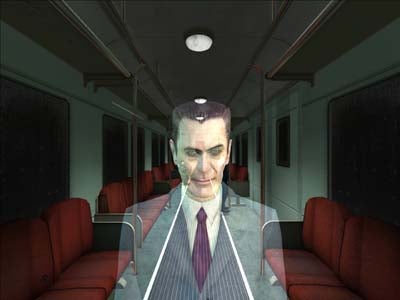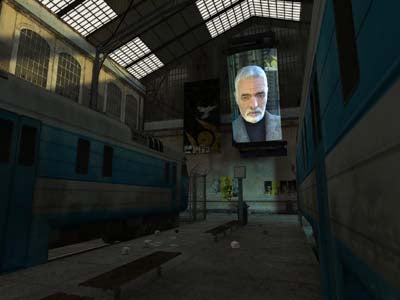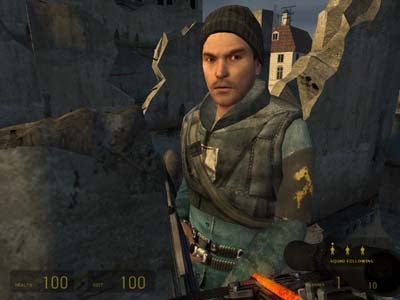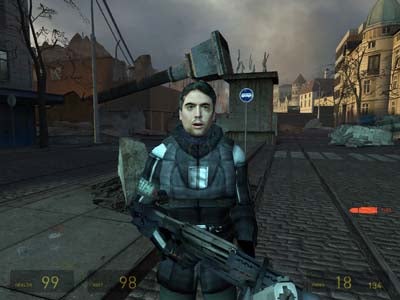Half-Life 2 Review
Half-Life 2
Looked upon by some as the gaming Messiah, Gordon Freeman, crowbar aloft, has finally arrived to save the planet. But does the game live up to the hype?

Verdict
Key Specifications
- Review Price: £30.00
On November 16 2004, gamers finally got to play what was quite simply was the most eagerly awaited game of all time. In a year that saw the arrival of blockbuster titles such as Far Cry, Doom 3 and Halo 2 for the Xbox, this was quite some achievement. But then no other game has had the same impact as the original Half-Life did. It wasn’t just the cutting-edge graphics of the first game that enthralled gamers worldwide. It was the fact that it was the first game that offered a plot that you actually cared about, meshing graphics and characterisation to pull you into the game.
Not surprisingly then, a lot was expected of the sequel. However, the wait for the game turned into a saga of its own. The much heralded 23 September 2003 release date came and went much to the chagrin of ATI and all those who had bought that company’s graphics cards expecting a free copy of the game to quickly materialise. There was uproar at the proposed Steam online content delivery service and then the game’s source code was dramatically stolen . All of it however, is water under the bridge, and on November 16 the game was finally released to the world. Like eveyone else, we’ve been trying to fit work and real life into the small space between our gaming sessions. Since release, a few niggles have been voiced concerning the reliability of Steam, the need for an Internet connection when launching the game for the first time for a once-only authentication, and a stuttering issue, but from our experience everything ran smoothly.
But if you’re a natural fence sitter, and haven’t already jumped aboard the Half-Life 2 bandwagon, you might well be wondering if the game is worth all the hype. The short answer is, oh yeah baby! Half-Life 2 is an incredible game. It’s not perfect to quite the extent that some have claimed, but it does meet expectations and even exceeds them at times.

Graphically, it’s no exaggeration to say that Half-Life 2 is the best looking game I’ve ever seen, making even Halo 2 look ordinary. Doom 3 may be technically more advanced offering per-pixel lighting, but as far as creating a world that feels real, nothing has ever come this close. Whereas Doom 3 takes place mostly in dark confined spaces, Half-Life 2 will take your breath away with its open air scenes while doing a good job indoors as well. All the graphical tricks that card manufacturers and game developers have been talking about are put to use here – high polygon count models, bump mapping, and a shader-based renderer that apparently is used by Pixar for its blockbuster animated movies – all work together to produce a truly stunning looking game. To see it at its best you’ll need a decent CPU and a DirectX 9 capable card, such as a Radeon 9800/X800 or an nVidia 6600 or 6800. nVidia’s GeForceFX cards don’t make the grade for DX9 due to poor performance, though a hack to make them use DX9, without running like treacle, is drifting around the Internet. As well as making the best use of your graphics hardware, Half-Life 2 also offers widescreen support. This ensures that if you’re playing on a widescreen monitor or projector you can actually see more of the game to the sides than you would on a regular 4:3 monitor, which really adds to the cinematic feel of the game. In the early levels, you’ll really drink in the level of detail the new Source engine offers. Sunlight flares brilliantly, walls and barrels are detailed and textured and faces are easily the most realistic you’ll have yet seen. If you’ve got full DX9 level hardware, you’ll be particularly impressed with the water. In Far Cry the water looked more like jelly, but in the Source Engine it’s totally convincing, rippling and reflecting everything realistically.

Always playing second fiddle to the ‘eye-candy’ is in game audio. This if anything is just as impressive as the graphics. The voice work is excellent, imbuing characters with feeling, and environments with atmosphere. Many of the sounds from the original game make a comeback, which really helps create that satisfyingly familiar Half-Life feel.
The drama starts as soon as you load up the game. The initial voice you hear is that of the mysteries G-Man, telling Gordon to wake up as he is “needed once again”. As with the first game you find yourself on a train, but the ride this time is brief, letting you quickly get on with exploring the world. You alight the train weaponless, finding yourself in a station. Immediately a strange hovering device floats over and blinds you as it takes a picture. You hear a booming voice from a talking head displayed on a large screen, welcoming you to ‘City 17’ Big Brother style (as in George Orwell, not Davina McCall). Masked troopers with unnerving electronic voices bark at you as you pass, and if you get to close they club you with cattle prods. In fact, after playing the opening scenes on the day of release I had to get on a train to go to a press briefing in London. As I got of the train and emerged into the large station at St. Pancras, I was immediately reminded of Half-Life 2’s opening scene. There were guards standing around in uniform, and I couldn’t help wondering if they’d hit me with a cattle prod if I came too close. Sad, but true.

As you soak up the tense atmosphere at the start of the game you’ll find yourself amazed at the way objects such as bottles and cans blow realistically around your feet. The troopers herd you through a turn-style and as you pass a woman asks pleadingly if there was anyone else on the train. She explaines that her husband was taken off a previous train for interrogation and that she was told he would follow in the next train. Somehow you know he’s never going to arrive. What’s impressive is how the quality of the voice work and the rich range of expression in the character model make you feel for the woman. Gordon doesn’t reply of course as once again he is a totally silent character. He also wears the same geeky glasses and goatie-beard – I reckon, Jeff Goldblum should play him in the touted movie version.
As you progress you begin to glean more information. Apparently, since your escape from Black Mesa, the world has been taken over by aliens known as the Combine. Dr Breen, head of Black Mesa is now acting as their puppet, convincing mankind to succumb to their will. There is even a description of a suppressing field preventing the world from producing children – painting a truly nightmarish Orwellian vision of the oppression of the alien occupation.

Emerging from the station, you’re treated to the power of the Source Engine in full effect. There’s the impressive building architecture, the cool shield effects by menacing looking gates, and the awesome ‘Striders’ – Tripod-like walkers that tower over you as they move round the city. But once you’ve soaked in the graphics and get into the game, you’ll realise that the real star of the show is actually the Havoc physics engine. Every object in the game behaves in a realistic fashion enabling you to interact with your surroundings in ground-breaking ways. This is undeniably great fun, and you’ll spend ages chucking things around and observing how the soldiers fly about as they get blown up. It also delivers genius moments like the game of catch you play with Alyx’s robot ‘dog’. This is made possible by the cleverest weapon in the game – the very nifty gravity gun, which enables you to pick up objects and use them as protection or hurl them at enemies. The most fun is picking up razor shards and using them to carve up hordes of attacking zombies.
At the start you’re quickly are reunited with Barney, the likeable guard from the original game and Dr Kleiner, the white-coated Professor. Later you meet Dr Eli Vance and daughter Alyx, a new character that Valve has succeeded in making into a believably attractive and intelligent individual. The interplay between the characters is impressive and there’s even time for some comedy moments with Dr Kleiner’s pet Headcrab. You soon get down to business though, and in a great moment, when you don your HEV suit from the first game, the classic Half-Life music starts up. Cool. Even better, you’re soon reunited with the iconic crowbar. Bliss. Seconds later you’re being chased by troopers and smashing your way though boxes in a bid to escape. Ah, Half-Life, my old friend, it’s good to be back.

From that point on, the pace of the game rarely lets up. One level set in a boat sees you speeding though canals as chasing Helicopters spray the water around with bullets. and drop exploding mines into your path. This level goes on for what seems like a long time, but it’s so involving that I never felt that it dragged.
There are 14 levels in all and atmosphere is a key ingredient in all of them. While the monsters jumping out from the dark in Doom 3 quickly got old, the variety of levels in Half-Life 2 keep things interesting. The game is littered with classic moments and it feels like you get the best bits of several games in one, without being derivative.
At one point, Alyx points out a tunnel saying, “That’s the way to Ravenhome… we don’t go there anymore”, leaving you in no doubt that that’s exactly where you’ll be heading very soon to kick some serious zombie ass. Which of course, you do. While the previous levels are frenetic vehicle-based chases set outside, this is a claustrophobic spooky level reminiscent of Resident Evil. The later levels let you control non-player characters (NPCs), as you conduct Guerrilla fighting through the streets of City 17. There might be sci-fi alien Striders walking about, but this level has a strong World War II feel to it, much like Call of Duty. In this scene you get to see the Striders up close, revealing them to be an amazing mix of organism and machinery (Carmack eat your heart out). Launching a rocket at the underbelly of these things is surely one of the best gaming moments ever. Shifting mood once again, the final level has an impressive large scale sci-fi feel to it, conjuring up the human battery fields of the first Matrix film.

So far then, I’ve done nothing but heap praise on the game, but in fact not everything is perfect. As you play though the game, Valve’s constant need to show off the physics capabilities of the engine does eventually start to feel a little contrived, with some puzzles seemingly existing for no other reason. The same goes for the myriad exploding barrels, which are always red and are seemingly everywhere. This makes it a little odd that the troopers seem to be trained to stand too close to these dangerous objects. Also, while you can pick things up, it does jar that you appear to have no hands. The worst culprit though, is the disappointing trooper AI. They work well in packs, using the terrain and any weapon close to hand. However on several occasions when there was only one trooper left, it just stood there while I walked up to it and shot it in the head.
The story is also decidedly linear. While this might bother some, I felt it perfectly suited the cinematic feel to the game. What’s more the open ended conclusion may frustrate some, particularly those who like to have all their questions answered and all the loose ends tied up neatly. Be warned, Half-Life 2 does no such thing. Instead it sets things up intriguingly for the third instalment, which like thousands of others I hope arrives sooner rather than later. I’m not sure I could wait another six years…
As for multiplayer, Counter-Strike: Source offers the same solidly addictive thrills as the original version with improved graphics, the main addition to gameplay deriving from the physics engine. Additionally, some three weeks after the game’s initial release, Valve made the surprise introduction of multiplayer using Half-Life 2’s own maps and weapons. It might be plain old deathmatch but it’s the gravity gun that offers a new slant on the genre. Killing your enemies by chucking a toilet at them is just as funny as it sounds, though repeatedly being killed by flying furniture does eventually get frustrating. The trick is being able to use the gravity gun to defend against objects being hurled at you, and knowing when to switch to conventional weapons. For a quick thrill, it’s a blast, but it’s unlikely to hold the same lasting appeal as Counter-Strike: Source.
”’Verdict”’
Undoubtedly worth the wait, Half-Life 2 is a stylish, involving and graphically stunning game. It largely makes good on its promises of bringing new levels of emotional connection to its characters and with its graphics and physics engine breaks new ground. If you only buy one game, ever, this is the one to get.


